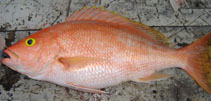http://www.fishbase.org/Summary/speciesSummary.php?genusname=Lutjanus&speciesname=vivanus ---> http://192.134.151.83/Summary/speciesSummary.php?genusname=Lutjanus&speciesname=vivanus
http://192.134.151.83/Summary/speciesSummary.php?genusname=Lutjanus&speciesname=vivanus ---> https://fishbase.mnhn.fr/Summary/speciesSummary.php?genusname=Lutjanus&speciesname=vivanus
https://fishbase.mnhn.fr/Summary/speciesSummary.php?genusname=Lutjanus&speciesname=vivanus ---> https://fishbase.mnhn.fr/summary/Lutjanus-vivanus.html
Lutjanus vivanus, Silk snapper : fisheries, gamefish

You can
sponsor
this page
Common name (e.g. trout)
Genus + Species (e.g. Gadus morhua)
-

-
About this page
-
Languages
-
User feedbacks
-
Citation
-
Uploads
-
Related species
-


 Silk snapper
Add your observation in
Fish Watcher
Upload your
photos
and
videos
Silk snapper
Add your observation in
Fish Watcher
Upload your
photos
and
videos
Pictures
|
Google image
 Lutjanus vivanus
Lutjanus vivanus
Picture by
Bryan, D.
Teleostei (teleosts) >
Eupercaria/misc
(Various families in series Eupercaria) >
Lutjanidae
(Snappers) > Lutjaninae
Etymology:
Lutjanus:
Malay, ikan lutjan, name of a fish
.
More on author:
Cuvier
.
Environment: milieu / climate zone / depth range / distribution range
Ecology
Marine; reef-associated; depth range 90 - 242 m, usually 90 - 140 m (Ref.
55
). Subtropical; 41°N - 30°S, 99°W - 32°W (Ref.
55
)
Western Atlantic: North Carolina, USA and Bermuda to São Paulo, Brazil (Ref.
57756
). Most abundant around the Antilles and the Bahamas.
Length at first maturity / Size / Weight / Age
Maturity: L
m
41.6
, range 24 - 26 cm
Max length : 83.0 cm TL male/unsexed; (Ref.
40637
); common length : 45.0 cm TL male/unsexed; (Ref.
55
); max. published weight: 8.3 kg (Ref.
4699
)
Dorsal
spines
(total): 10 - 11;
Dorsal
soft rays
(total): 13-14;
Anal
spines
: 3;
Anal
soft rays
: 7 - 8. Preopercular notch and knob weak. Pectoral fins long reaching level of anus. Scale rows on back rising obliquely above lateral line. Back and upper sides pink to red, grading to pink with a silvery sheen ventrally; sides with very fine undulating yellow lines; the fins mostly reddish or pale yellow. Young specimens (under about 25 cm) with a blackish spot on upper side below anterior dorsal soft rays.
Adults are common near the edge of the continental and island shelves; also found in deeper waters (below 200 m); usually ascending to shallow water at night. They feed mainly on fishes, shrimps, crabs, gastropods, cephalopods, tunicates and some pelagic items including urochordates. Marketed fresh. Said to be a good food fish (Ref.
5521
).
Life cycle and mating behavior
Maturity
|
Reproduction
|
Spawning
|
Eggs
|
Fecundity
|
Larvae
Spawning occurs over most of the year in lower latitudes, but is seasonal (spring and summer) toward the northern and southern limits of the distribution.
Allen, G.R.
, 1985. FAO Species Catalogue. Vol. 6. Snappers of the world. An annotated and illustrated catalogue of lutjanid species known to date. FAO Fish. Synop. 125(6):208 p. Rome: FAO. (Ref.
55
)
IUCN Red List Status (Ref.
130435
)
Least Concern (LC)
; Date assessed:
10 October 2015
CITES
Not Evaluated
Not Evaluated
Threat to humans
Reports of ciguatera poisoning (Ref.
55
)
Human uses
Fisheries: commercial; gamefish: yes
FAO - Fisheries:
landings
; Publication:
search
|
FishSource
|
Sea Around Us
More information
Countries
FAO areas
Ecosystems
Occurrences
Introductions
Stocks
Ecology
Diet
Food items
Food consumption
Ration
Common names
Synonyms
Metabolism
Predators
Ecotoxicology
Reproduction
Maturity
Spawning
Spawning aggregation
Fecundity
Eggs
Egg development
Age/Size
Growth
Length-weight
Length-length
Length-frequencies
Morphometrics
Morphology
Larvae
Larval dynamics
Recruitment
Abundance
BRUVS
References
Aquaculture
Aquaculture profile
Strains
Genetics
Electrophoreses
Heritability
Diseases
Processing
Nutrients
Mass conversion
Collaborators
Pictures
Stamps, Coins Misc.
Sounds
Ciguatera
Speed
Swim. type
Gill area
Otoliths
Brains
Vision
Tools
E-book
|
Field guide
|
Identification keys
|
Length-frequency wizard
|
Life-history tool
|
Point map
|
Classification Tree
|
Catch-MSY
|
Special reports
Check for Aquarium maintenance
|
Check for Species Fact Sheets
|
Check for Aquaculture Fact Sheets
Download XML
Summary page
|
Point data
|
Common names
|
Photos
Internet sources
AFORO (otoliths)
|
Aquatic Commons
|
BHL
|
Cloffa
|
BOLDSystems
|
Websites from users
|
Check FishWatcher
|
CISTI
|
Catalog of Fishes
:
genus
,
species
|
DiscoverLife
|
ECOTOX
| FAO - Fisheries:
landings
; Publication:
search
|
Faunafri
| Fishipedia |
Fishtrace
| GenBank:
genome
,
nucleotide
|
GloBI
|
Google Books
|
Google Scholar
|
Google
|
IGFA World Record
|
MitoFish
|
National databases
|
Otolith Atlas of Taiwan Fishes
|
PubMed
|
Reef Life Survey
|
RFE Identification
| Socotra Atlas |
Tree of Life
| Wikipedia:
Go
,
Search
| World Records Freshwater Fishing |
Zoological Record
Estimates based on models
Preferred temperature (Ref.
123201
): 17.3 - 25.2, mean 21.2 °C (based on 73 cells).
Phylogenetic diversity index (Ref.
82804
): PD
50
= 0.5000 [Uniqueness, from 0.5 = low to 2.0 = high].
Bayesian length-weight: a=0.01479 (0.01305 - 0.01676), b=2.97 (2.94 - 3.00), in cm total length, based on LWR estimates for this species (Ref.
93245
).
Trophic level (Ref.
69278
): 3.1 ±0.5 se; based on diet studies.
Generation time: 11.0 ( na - na) years. Estimated as median ln(3)/K based on 2
growth studies.
Resilience (Ref.
120179
): Low, minimum population doubling time 4.5 - 14 years (K=0.09-0.32; tm=5).
Prior r = 0.28, 95% CL = 0.17 - 0.49, Based on 2 stock assessments.
Fishing Vulnerability (Ref.
59153
): Moderate vulnerability (37 of 100).
Price category (Ref.
80766
):
High
.
Nutrients (Ref.
124155
): Calcium = 14 [7, 23] mg/100g; Iron = 0.283 [0.165, 0.486] mg/100g; Protein = 18.7 [17.2, 20.2] %; Omega3 = 0.178 [0.106, 0.300] g/100g; Selenium = 43.5 [22.3, 82.9] μg/100g; VitaminA = 65.2 [11.3, 329.9] μg/100g; Zinc = 0.326 [0.234, 0.494] mg/100g (wet weight);
Back to Search
Random Species
Back to Top
Accessed through:
Not available
FishBase mirror site :
localhost
Page last modified by :
mrius-barile
- 20 July 2016
Fatal error
: Uncaught ArgumentCountError: Too few arguments to function checkEcotox(), 1 passed in /var/www/html/summary/speciessummary.php on line 2304 and exactly 3 expected in /var/www/html/includes/speciessummary.lib.php:2579 Stack trace: #0 /var/www/html/summary/speciessummary.php(2304): checkEcotox() #1 {main} thrown in
/var/www/html/includes/speciessummary.lib.php
on line
2579
|